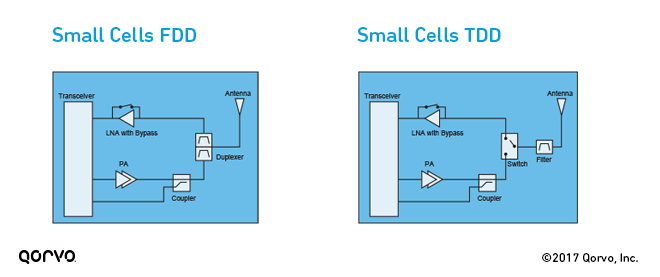Top Trends and Overcoming Design Challenges in Small Cells (Part 2)
June 1, 2017
This is the second blog post in a 2-part series looking at small cell base stations.
In the first part of our series, we covered the basics of small cells and how they fit into the evolution of 4G and 5G. In this final post in the series, we sat down with Tuan Nguyen, Qorvo's product line director for our wireless infrastructure products, to get his insights on the latest design challenges and trends in the small cell market.
What are some of the latest trends related to small cells?
- LTE for usage in unlicensed bands: Also known as LTE-U and Licensed Assisted Access (LAA), unlicensed spectrum is starting to be implemented in small cell base stations. This unlicensed band access overlays LTE over the Wi-Fi band and provides carriers with another pipeline where they can control and guarantee quality of service (QoS).
- Increased number of bands per system: A couple of years ago, a lot of small cell base stations were just for single band. Many are now dual band, and moving forward in the next year or two, customers are developing and implementing triple-band systems. This will increase the system-level requirements for small cell solutions, both in terms of the number of components required and the complexity of the overall system design.
- Customers designing with more efficient systems: Systems targeted for shipment later this year are implementing linearization, which requires power amplifiers that are much more efficient than they are today. Today, systems are designed where the power amplifiers typically operate in backed-off mode, which means that the system just works without worrying how the PA performs. Linearization uses feedback so that the signal gets "cleaned up" by the baseband chipset and allows PAs to operate with much higher efficiency, translating into lower power consumption for the system.
- Continued growth: The small cell market has been emerging for a while, but over the past two years we have seen significant growth, at 50% year over year. Multiple analysts such as IHS Technology and Mobile Experts expect that small cell deployments will total more than 1 million small cell base stations for 2017.
Analyst Reports
Learn more about the latest trends in small cells:
- Research Note: Small Cell Market Sees Solid Growth in 2016, Driven by Indoor Shipments (IHS, March 2017)
- Report: Small Cells 2017 (Mobile Experts, March 2017; requires subscription)
What are common or new challenges customers have when designing for small cell applications?
- Increasing number of bands per system: Customers historically are designing these small cell systems for MIMO applications (multiple input/multiple output), which typically have 2 transmitters and 2 receivers per frequency band. As base stations incorporate multiple channels, it means more components — for instance, a three-band system would need six separate PAs (2 transmitters x 3 bands = 6 PAs) — which adds complexity, size and power consumption. Customers need the systems to be easy to design, easy to use (i.e., internally matched components), and efficient.
- Ensuring good isolation and band separation for the transmit/receive channels, specifically for Band 3 (1.8 GHz). The band separation is only 20 MHz, which requires very high isolation out of the duplexer.
How does Qorvo help our customers solve these design challenges?
Over the last two years, we've significantly expanded our portfolio of small cell filters and PAs, targeting products for specific frequency bands. Our customers have seen some of the following key benefits:
- Filters for small cells: Qorvo's BAW technology delivers high isolation and performance, particularly in our duplexers. Our small cell duplexers provide very good passive intermodulation (PIM) by reducing nonlinearities that may be introduced in the duplexer — which our customers have said is very important.
- Small cell power amplifiers: Qorvo PAs are internally matched and designed to provide temperature compensation inside the circuitry. This means our PAs are effectively plug and play and easy to use, which allows customers to easily design their system.
Qorvo Articles on Small Cells
Read what Qorvo experts have to say:
- Energy Efficiency in the Telecommunications Network (RF Globalnet, July 2016)
- Small Cells Help Keep 5G Connected (Microwaves & RF, March 2016)
- The Buzz About Wireless Small Cells (RF Globalnet, Nov. 2015)
Qorvo has a complete small cell portfolio and is the only supplier to provide the entire RF front end, including low noise amplifiers (LNAs), PAs, filters/duplexers and switches. All of our small cell products provide:
- High linearity
- High isolation
- Low power consumption
- Low link budget
Visit our Small Cells application page for all our latest products supporting this market, as well as block diagrams for our small cell FDD and TDD solutions.
Have another topic that you would like Qorvo experts to cover? Email your suggestions to the Qorvo Blog team and it could be featured in an upcoming post. Please include your contact information in the body of the email.

